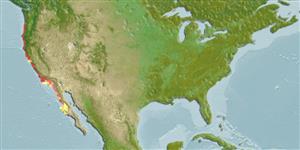>
Perciformes/Zoarcoidei (Eelpouts and pricklebacks) >
Cebidichthyidae (Monkeyfaces)
Etymology: Cebidichthys: Latin, cebus, cebi, derived from caput- itis= head + Greek, ichthys = fish; violaceus: Cebidichthys comes from 2 Greek words: sapajou (a kind of monkey) and fish (hence, monkey fish); violaceus is Latin for violet (Ref. 43439).
More on author: Girard.
Environment: milieu / climate zone / depth range / distribution range
Ecología
marino demersal; no migratorio (Ref. 43439); rango de profundidad 0 - 24 m (Ref. 51666), usually 0 - 1 m (Ref. 43439). Subtropical; 46°N - 27°N, 126°W - 113°W
Eastern Pacific: southern Oregon, USA to northern central Baja California, Mexico; rare south of Point Conception, California, USA.
Length at first maturity / Tamaño / Peso / Age
Maturity: Lm 40.6, range 36 - 45.72 cm
Max length : 76.0 cm TL macho / no sexado; (Ref. 2850); edad máxima reportada: 18 años (Ref. 43439)
Common inshore, in tide pools or shallow rocky areas, from the intertidal zone to 24 m depth. May remain out of water under rocks or seaweed (Ref. 31184). Feeds mainly on crustaceans and algae. Breathes air (Ref. 31184) and can remain out of water for 15-35 hours if kept moist (Ref. 51276). Demersal spawners in nearshore habitats (Ref. 56049). Oviparous (Ref. 205). Commonly caught by 'poke-poling', a method using a long bamboo pole with a very short wire leader and baited hook. Good eating.
Oviparous (Ref. 205). Nests in crevices (Ref. 205). A parent coils about the eggs (Ref. 205).
Eschmeyer, W.N., E.S. Herald and H. Hammann, 1983. A field guide to Pacific coast fishes of North America. Boston (MA, USA): Houghton Mifflin Company. xii+336 p. (Ref. 2850)
IUCN Red List Status (Ref. 130435)
Threat to humans
Harmless
Human uses
Pesquerías: pesquerías de subsistencia; pesca deportiva: si; Acuario: Comercial
Más información
Age/SizeCrecimientoLength-weightLength-lengthLength-frequenciesMorfometríaMorfologíaLarvaDinámica larvariaReclutamientoAbundanciaBRUVS
ReferenciasAcuiculturaPerfil de acuiculturaRazasGenéticaElectrophoresesheritabilidadEnfermedadesProcesamientoNutrientsMass conversion
ColaboradoresImágenesStamps, Coins Misc.SonidosCiguateraVelocidadTipo de nataciónSuperficie branquialOtolitosCerebrosVisión
Herramientas
Special reports
Download XML
Fuentes de Internet
Estimates based on models
Preferred temperature (Ref.
123201): 12.2 - 19, mean 15.9 °C (based on 70 cells).
Phylogenetic diversity index (Ref.
82804): PD
50 = 1.0000 [Uniqueness, from 0.5 = low to 2.0 = high].
Bayesian length-weight: a=0.00389 (0.00180 - 0.00842), b=3.12 (2.94 - 3.30), in cm total length, based on all LWR estimates for this body shape (Ref.
93245).
Nivel trófico (Ref.
69278): 2.3 ±0.2 se; based on diet studies.
Generation time: 6.6 ( na - na) years. Estimated as median ln(3)/K based on 1
growth studies.
Resiliencia (Ref.
120179): Medio, población duplicada en un tiempo mínimo de 1.4-4.4 años (tm=4; tmax=18; Fec = 18,000).
Fishing Vulnerability (Ref.
59153): Moderate to high vulnerability (54 of 100).
